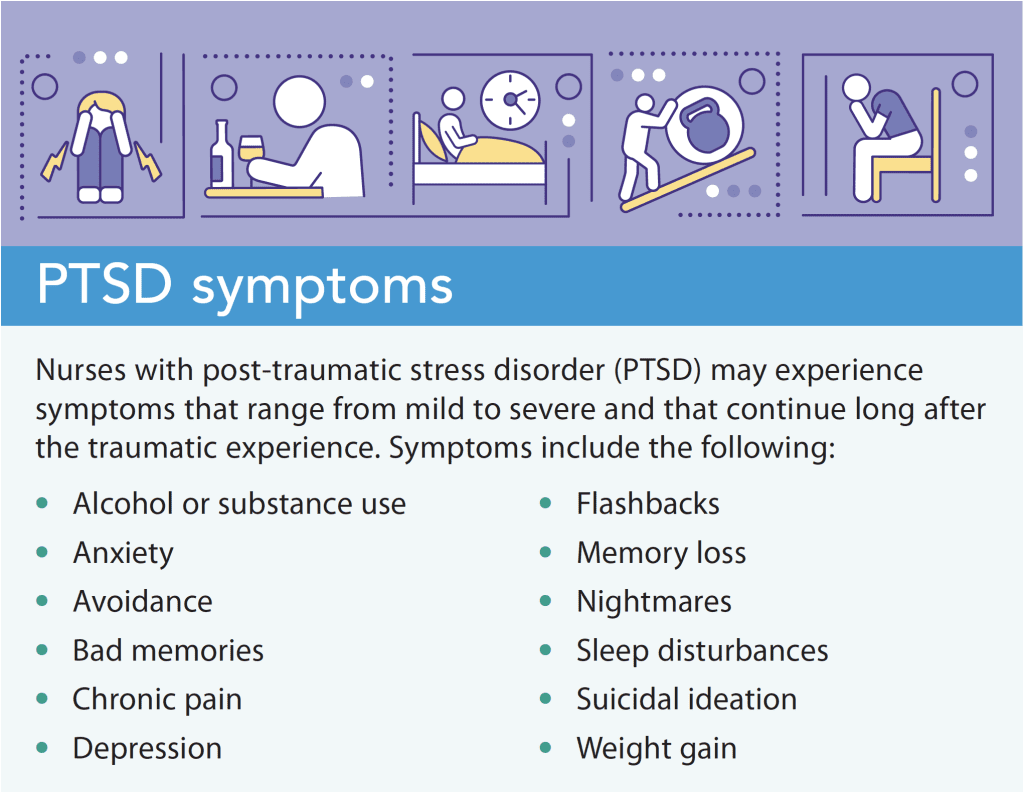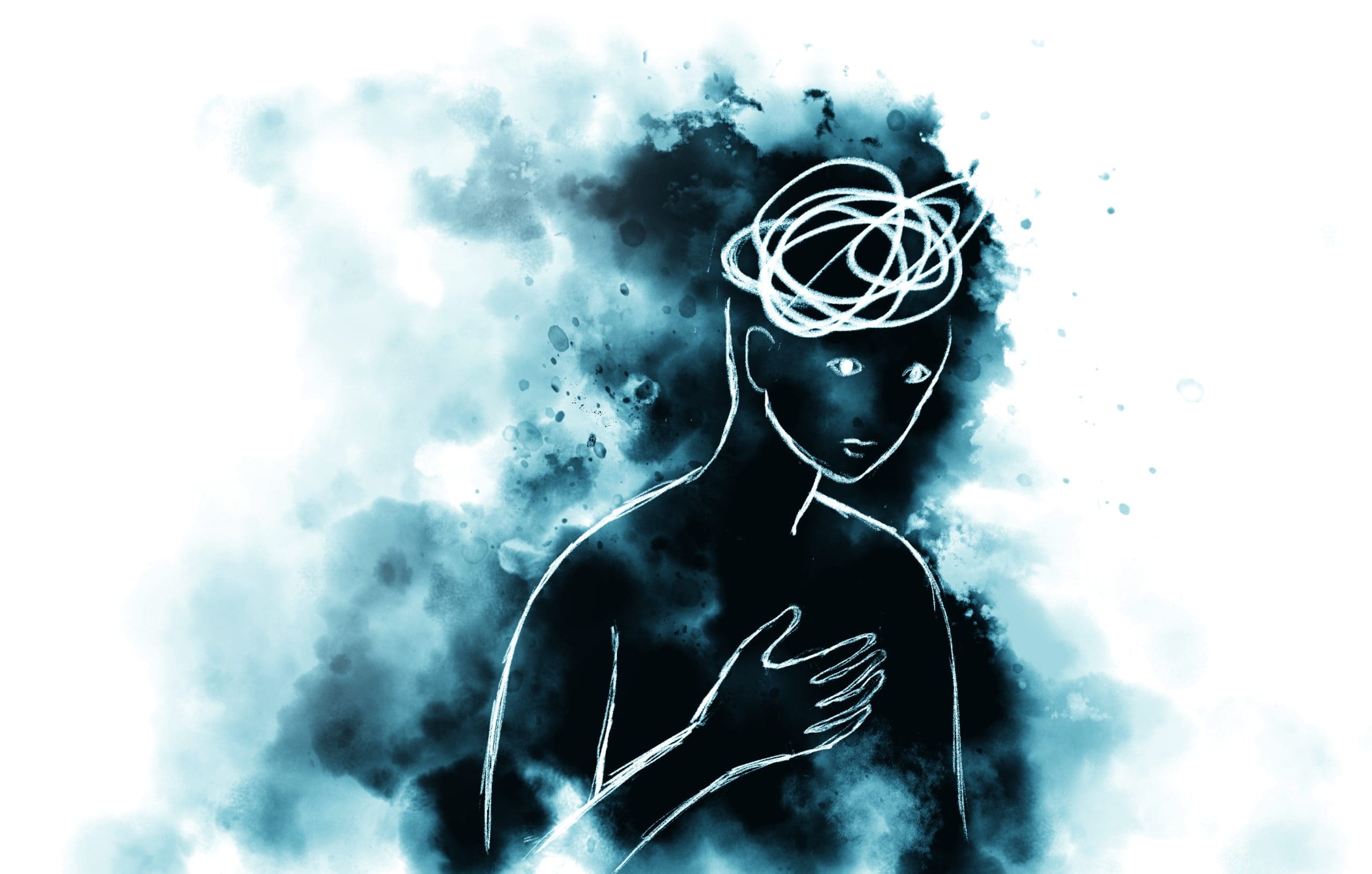Learn to identify and manage this condition in yourself and your colleagues.
- Frontline nurses are at high risk for developing PTSD as a result of direct or indirect exposure to traumatic situations and events during the COVID-19 pandemic.
- PTSD is a growing concern for frontline nurses.
- PTSD may affect a nurse’s ability to provide quality patient care.
For almost 3 years, nurses have been serving on the frontlines of the pandemic, which increases their risk for post-traumatic stress disorder (PTSD). Individuals with PTSD experience various symptoms, including anxiety, depressed mood, sleep disturbances, chronic pain, avoidance, and memory loss. The most effective treatment involves medication combined with cognitive-behavioral therapy. Self-care strategies, such as exercise and meditation, can aid resilience and healthy coping.
PTSD defined
PTSD occurs as the result of witnessed or experienced trauma or traumatic event, such as war, natural disaster, serious accident, abuse, violence, or shock. Throughout the COVID-19 pandemic, PTSD has been observed and reported in frontline nurses. Most nurses work in high-stress environments and encounter traumatic events throughout their careers, but the insufficient resources, lack of nursing staff, limited supplies, and many unknowns of the illness left nurses feeling unprepared. They feared for their own safety and worried about exposing their loved ones to the illness. They also encountered ongoing changes in virus information and treatment protocols.
The World Health Organization estimates that from 80,000 to 180,000 healthcare workers died from COVID-19 between January 2020 and May 2021. In addition, available data from 119 countries suggest that only two in five healthcare workers were fully vaccinated in September 2021. In most countries, frontline nurses were the healthcare workers most affected by the illness.
PTSD prevalence among nurses
Before the pandemic, 10% to 50% of frontline healthcare workers experienced PTSD. In May 2021, the American Psychiatric Association reported a PTSD rate of 49.5% among nonphysician healthcare workers. According to an integrative review by Schuster and Dwyer, about 96% of nurses reported having one or more symptoms of PTSD, with around 21% meeting the diagnostic criteria for the condition.
Factors linked to PTSD in frontline nurses include the nursing role (changes in nursing assignments) and aggression, violence, and trauma in the workplace. Other factors recognized to trigger PTSD include workplace frustrations, such as limited staffing or other resources; lack of organizational support; negative perception of patient care; few supportive relationships at home or at work; deaths of young patients; and patient suffering. Increased workplace demands during the pandemic likely exacerbated these factors. According to Becze, although many factors increase nurses’ risk of PTSD, interpersonal factors (healthy coping strategies, resilience, and outgoing personalities) reduce their likelihood of experiencing the disorder.
Differential diagnoses
PTSD can be difficult to diagnosis and frequently is misdiagnosed as acute stress disorder (ASD), which is similar to PTSD but with a shorter duration. Typically, ASD symptoms develop immediately after a traumatic event and last from 3 days to 1 month. PTSD diagnosis occurs when symptoms last beyond a month. Other differential diagnoses for PTSD include dissociative disorders, adjustment disorders, generalized anxiety disorder, depression, panic disorder, phobias, and substance use disorders.
Misdiagnosing PTSD can lead to inappropriate or delayed care, making it difficult to treat and resulting in significant psychological, physical, and social issues. PTSD rarely resolves on its own. Left untreated, PTSD increases the risk for many life-threatening conditions, such as type 2 diabetes, hypertension, heart disease, chronic pain, depression, and substance use disorders.
Diagnostic criteria
Diagnostic and Statistical Manual of Mental Disorders, 5th edition, diagnostic criteria for PTSD include indirect or direct exposure to a traumatic event and four categories of symptoms: intrusion, avoidance, negative conditions/emotional numbing, and hyperarousal/
reactivity. Diagnosis requires that symptoms be present for more than 1 month and result in functional impairment and clinically significant distress. (See PTSD symptoms.)


Throughout the COVID-19 pandemic, frontline nurses have been exposed to many psychological and physical stressors. In a study of 637 nurses in Australia by Sahebi and colleagues, 34% perceived that they were providing slightly or significantly worse patient care than before the pandemic. These stressors frequently result in anger, depressed mood, anxiety, emotional instability, and irritability. In addition, frontline nurses report isolating themselves out of fear of spreading the infection to loved ones. (See A nurse’s story.)
A NURSE’S STORY
Kim Trowbridge, RN, a nurse with 20 years of experience, described the most terrifying day of her career: “I was asked to go to a COVID hotspot, a facility that eventually lost over two-thirds of its residents to the virus. What I saw that day will be forever etched in my soul. The black garbage bags for gowns, staff crying and looking like deer in the headlights, no more [sanitizing wipes], instead there were buckets of bleach water all around to wipe things down, and all the dead patients. My phone in a ziplock as I was terrified I would bring this plague home to my family. I pronounced four that day. FaceTime with families. Four calls to tell their loved ones they had died, four souls I will always remember.”
After that event, Trowbridge experienced intrusive thoughts, nightmares, and anxiety attacks that became more frequent as the pandemic persisted. By the end of August 2020, she slept only a few scattered hours each night. She described seeing the faces of the patients who died, experiencing a heavy nagging sadness, and crying frequently. Her post-traumatic stress disorder (PTSD) symptoms included anxiety, insomnia, and agitation, which resulted in poor relationships with her family. She self-isolated from family and friends and felt physical and psychological exhaustion that she’d never experienced before.
As Trowbridge’s PTSD symptoms worsened, she resigned from her position as a community hospice case manager. Her new role came with a big pay cut, but it’s given her the time she needed to heal and remember why she’s a nurse. After more than 10 months, she stopped having nightmares. The patients with COVID-19 still appear in her dreams, but now they’re smiling. Trowbridge continues to see fellow nurses struggling with PTSD symptoms and reported that care quality suffers as a result. Many of her former colleagues have left bedside nursing.
Treatment
Nurses experiencing PTSD should be encouraged to seek treatment. The National Alliance on Mental Illness recommends psychotherapy and medication with a combination of complementary therapies such as aqua therapy, yoga, mindful meditation, and acupuncture. Treatment can be provided in-person or via telehealth programs.
Pharmacologic treatment
No single medication can treat all PTSD symptoms. Providers consider individual preference and current symptoms when selecting pharmacologic treatment. Selective serotonin reuptake inhibitors and serotonin-norepinephrine reuptake inhibitors aid in reducing PTSD symptoms. Typically, they’re continued for 6 months to a year to prevent recurrence or relapse.
In most cases, PTSD can’t be treated with medications alone. The psychological trauma associated with the condition creates side effects that require a combination approach to yield the best treatment results. Nurses experiencing PTSD should talk with their primary care providers about their treatment options and receive a referral for a psychiatrist or therapist.
Nonpharmacologic treatment
Frontline nurses may benefit from biopsychosocial treatment, a multifaceted approach with proven outcomes for such healthcare workers and the highest rate of return to optimum mental health. A team of providers conducts biopsychosocial treatment, which focuses on self-management. The treatment demonstrates links among the psychological (coping skills, past trauma, self-esteem), biological (physical health, gender, genetic vulnerabilities), and social aspects (family circumstances, peers, social support) of an individual to help determine how they contribute to health and illness. The patient actively participates in the recovery process.
Several types of psychotherapy can aid recovery. Cognitive processing therapy with a psychotherapist works by focusing on the self-blame and negative thinking that accompanies PTSD. Eye movement desensitization and reprocessing uses measured exposure to traumatic memories with alternating stimuli in structured sessions with a certified healthcare provider. This therapy is specially designed for treating trauma.
Group therapy allows people with the same experiences to provide support for one another, which helps build resilience and reduce feelings of isolation. It also works to decrease feelings of shame or guilt. Exposure therapy with a trained professional assists those with PTSD to safely face their trauma while teaching them how to cope effectively and safely. Recently, virtual reality programs have become popular for delivering exposure therapy in clinic and home settings.
Self-care strategies
Self-care strategies can help nurses build resilience against PTSD and provide robust coping mechanisms. Many nurses may consider self-care selfish. A good support network at work and at home can remind them that self-care aids recovery and their ability to care for others. Ignored stressors may lead to medication errors, lower quality-of-care scores, patient falls, and burnout.Some self-care strategies include regular exercise, mindful meditation, good sleep hygiene, regular leisure and recreational activities, breaks at work, connection with loved ones, and professional help when needed. Self-care is about finding a balance among work, family, social life, and physical and mental health needs.
Healthy Nurse, Healthy Nation (healthynursehealthynation.org) offers online self-care resources to nurses. It includes free apps and tools to promote mental health, as well as podcasts, hotlines, self-assessments, and other resources.
Healthy lives, safe patient care
Many nurses serving on the frontlines during the COVID-19 pandemic experience PTSD symptoms that range from anxiety, depressed moods, and sleep disturbance to suicidal ideation, alcohol or substance use, and flashbacks. With proper treatment from trained professionals, nurses with PTSD can learn to manage their symptoms and recover. Critical to recovery is self-care, which provides nurses with strategies to maintain their physical, emotional, and mental health so they can live healthy lives and safely care for patients. AN
Lisa Draze is a nurse practitioner working in psychiatry for Behavioral Care Solutions in Madison, Wisconsin.
Key words: post-traumatic stress disorder, PTSD, COVID-19, pandemic



















3 Comments. Leave new
This article was exactly what I needed to read tonight. You nailed every thought and feeling I have had since the start of the pandemic. I cried to my therapist just today over the shame I feel for my PTSD, wondering why I am suffering so badly when it seems other nurses can just carry on. If these feelings can be captured so articulately here, surely I am one of many who is experiencing them, which helps me feel less alone. It also helped me see that I’m already doing so much of the healing work described here. That feels hopeful to me. Thank you writing this.
I am a cna at a nursing home that experienced covid outbreak,and I can relate to the feelings others are feeling. It is something only someone who has been there and went through same thing can understand….
In turn, your comment did the same thing for me. After 2.5 years on the COVID ICU (and being in grad school full time), I have taken a leave of absence to finish my last semester of school. But really, I should have left a very long time ago. I have expressed the same sentiments to my therapist— feeling as though I’m “weak”, or wondering what could possibly be so wrong with me when it seems like my colleagues have just moved on. I feel stuck, and even worse, I feel guilty for it. You are not alone. Wholeheartedly, i thank you for wading through the shit with the rest of us. But I hope that you truly know in your heart, it is okay to FINALLY take a break/walk away from something that no longer serves you. Or, worse, does nothing but harm you.
Take care of yourself.